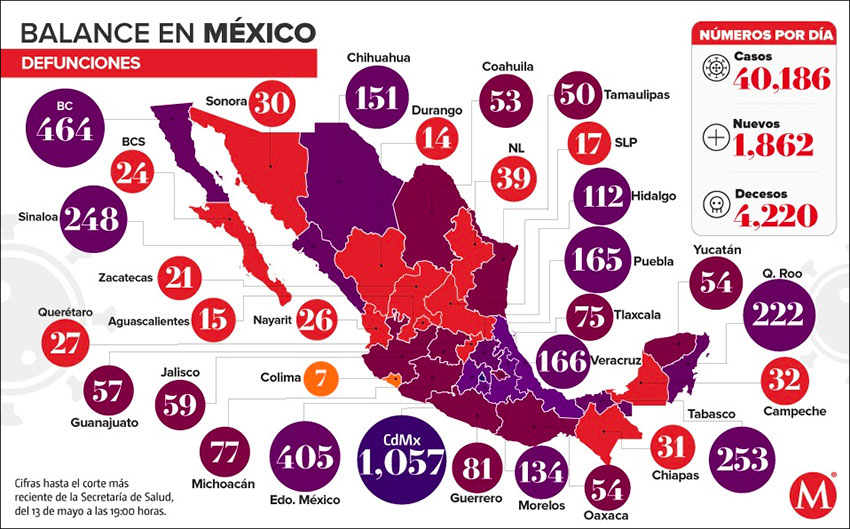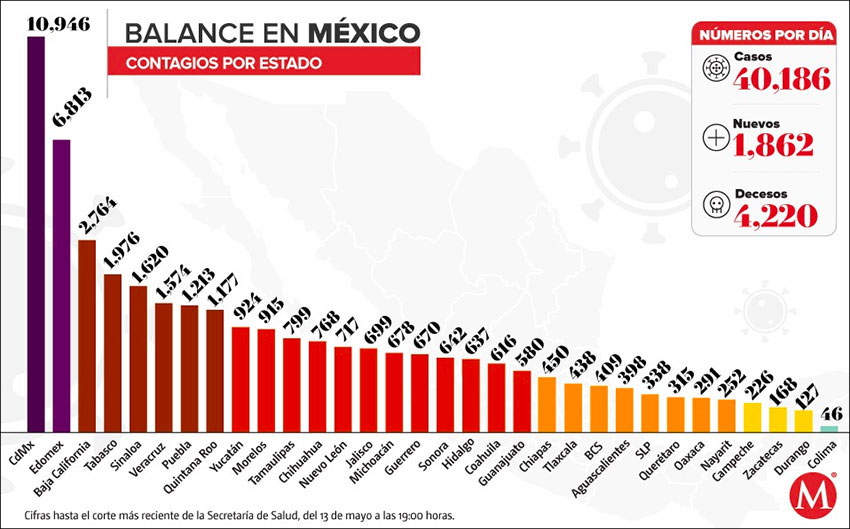As Mexico moves toward a “new normal” while the Covid-19 pandemic continues to grow, an increasing number of experts are calling for testing to be ramped up in order to detect more cases and limit new outbreaks of the disease.
The federal government revealed a three-phase plan on Wednesday that will see social distancing measures gradually lifted on a state by state basis depending on the severity of their outbreaks starting on June 1.
But experts warn that reopening the economy and allowing people to return to their normal day-to-day activities without first testing more widely for Covid-19 could lead to a second wave of infections that is worse than the first.
Alejandro Macías, an infectious disease doctor, former government health commissioner and member of the National Autonomous University’s coronavirus commission, highlighted that even though the government is taking steps to reopen the economy, Mexico is still in the most critical phase of the pandemic.
He told the newspaper El Universal that it is unlikely that Mexico has already reached the peak of the pandemic and that without more testing – almost 150,000 people, or about 1,100 per 1 million inhabitants, have been tested to date – there will inevitably be large numbers of new cases.

“The risk of not testing but wanting to go back to normal is that there will be outbreaks not just in the community but in industries, as happened in the meat industry in the United States,” Macías said.
The risk of Covid-19 reappearing in parts of the country where outbreaks were thought to have been controlled is very high because nowhere near 100% of the population has been infected, he said. That means that there is still a very large number of potential hosts for the virus.
“I believe that the reasoning for doing so few tests cannot be maintained,” Macías said, referring to the government’s assurances that it can effectively monitor the development of the pandemic via its epidemiological surveillance system.
“That Mexico is one of the countries that has done the fewest tests cannot be defended, … I believe we must do more,” he said.
Rafael Lozano, a professor at the Institute for Health Metrics and Evaluation at the University of Washington and a former director of health information at Mexico’s Health Ministry, asserted that testing helps save lives and that lockdown measures cannot be lifted without first significantly increasing the number of people who have been tested.
“Timely diagnoses are needed in order to be able to identify people who require isolation and treatment,” he said, adding that the plan to lift social distancing restrictions shouldn’t be developed until after widespread testing has taken place.
If testing is not ramped up before restrictions are eased, the pandemic could worsen in areas already suffering from large outbreaks, Lozano said. If restrictions are lifted “hastily,” he added, “there is no reason to think that there won’t be exponential spread.”
The academic charged that authorities should wait for at least two weeks to pass without any coronavirus-related deaths in a certain area before relaxing isolation measures.
Rodolfo de la Torre, director of social development at the Espinosa Yglesias Study Center, a Mexico City think tank, also said that more testing is needed before the government declares an end to national social distancing, which is set to be superseded by state-based restrictions at the start of next month.
A return to “normality” cannot even be thought of without first performing more tests, he said.
“That’s the only way … to avoid infections en masse. … The government is acting rashly in the return to normality; hopefully they’ll take the suggestions of academics and epidemiologists into account and apply them in their plan. … A strategy that looks after the health of Mexicans has to be drawn up because a new outbreak … could be worse than what we’re going through now,” de la Torre said.
The government’s announcement of its color-coded “stoplight” system to determine each state’s readiness to return to the “new normal” came just hours before the Health Ministry reported that the number of confirmed cases of Covid-19 in Mexico had passed 40,000 and that the death toll had exceeded 4,000.

At Wednesday night’s press briefing, Director of Epidemiology José Luis Alomía reported 1,862 new coronavirus cases, increasing the total number of accumulated cases to 40,186, and 294 fatalities, lifting the death toll to 4,220.
The daily death toll was the second highest since the first coronavirus-related fatality was reported on March 18. The highest death toll, and the biggest single-day increase in case numbers, were reported a day earlier on Tuesday.
Based on confirmed cases and deaths, the fatality rate in Mexico is now 10.5 per 100 cases, a figure that has crept up steadily in recent weeks. Mexico City, the epicenter of the country’s coronavirus crisis, has now recorded more than 1,000 coronavirus-related deaths and is approaching 11,000 confirmed cases, according to official data.
Eleven of Mexico’s 32 states have triple-figure death tolls, with Baja California, México state and Tabasco reporting the most after the capital.
Of the more than 40,000 confirmed cases, 9,378 are currently considered active, a figure that has increased over the past two days after declining for the first time in almost three weeks on Monday. Alomía said that there are also 24,856 suspected cases of Covid-19 across the country.
Later in the press briefing, Deputy Health Minister Hugo López-Gatell said that the government is prepared to change its plan to reopen the economy and return to a semblance of normality if it sees that case numbers are spiking considerably.
“I want to make it very clear that the government of Mexico has the attitude that if something goes wrong, … we’ll change course according to what is needed,” he said.
López-Gatell said that the government is aiming to identify the optimal time to relax restrictions in different parts of the country, asserting that there are no established guidelines or World Health Organization document that give concrete advice on the subject.
“We’re still looking for the moment,” he said, adding that state governors will be able to take their own decisions about which restrictions should be lifted and which should remain in place.
Source: El Universal (sp), Milenio (sp)